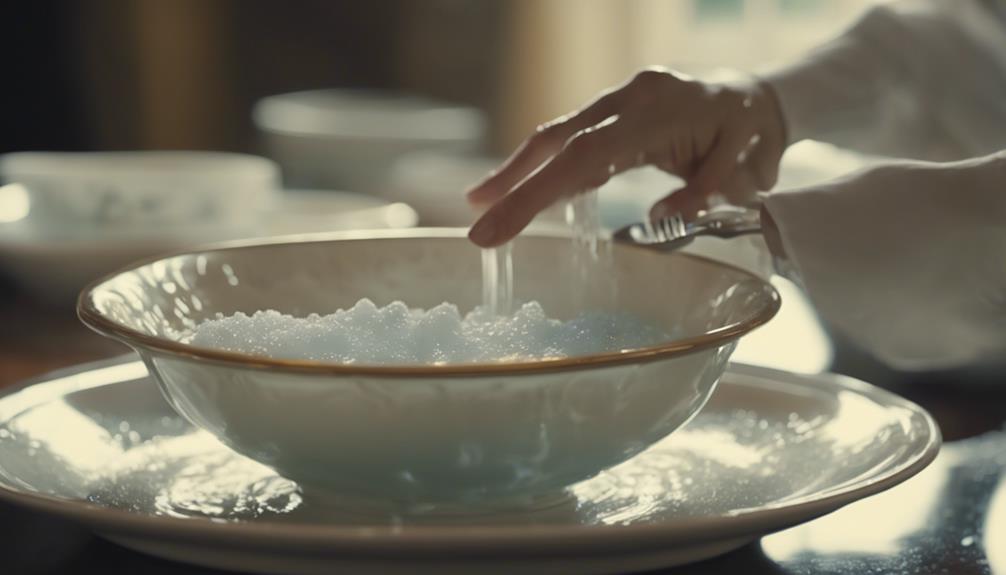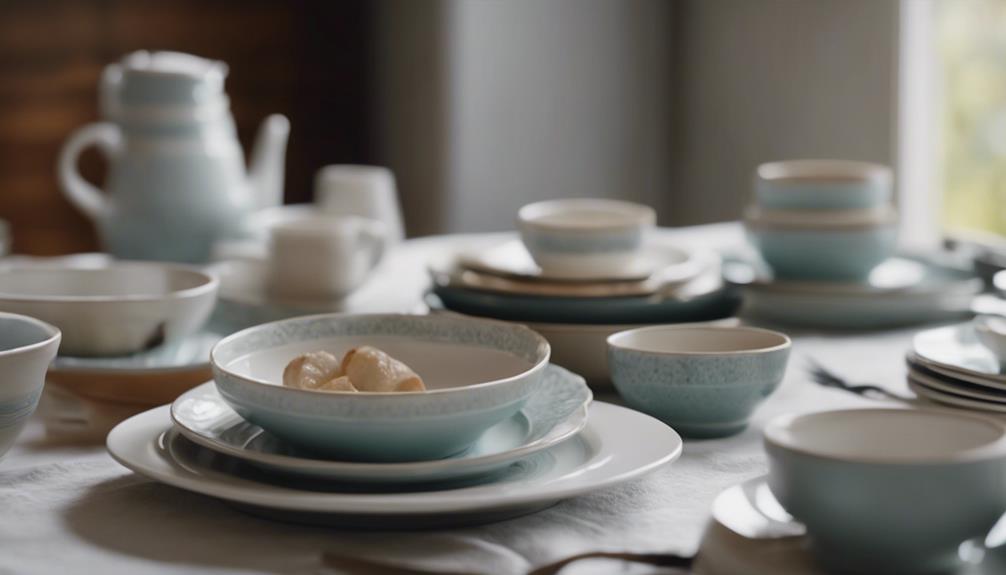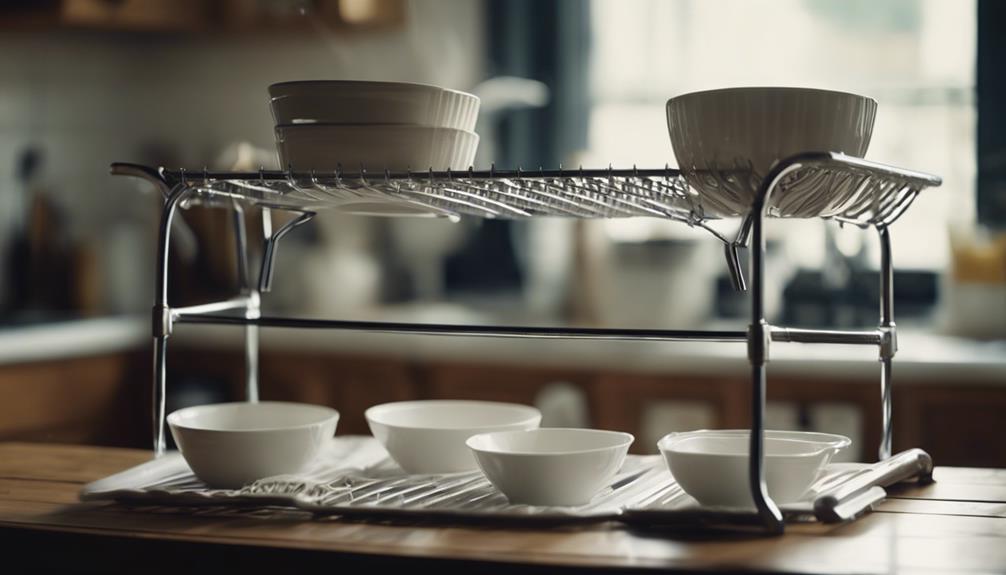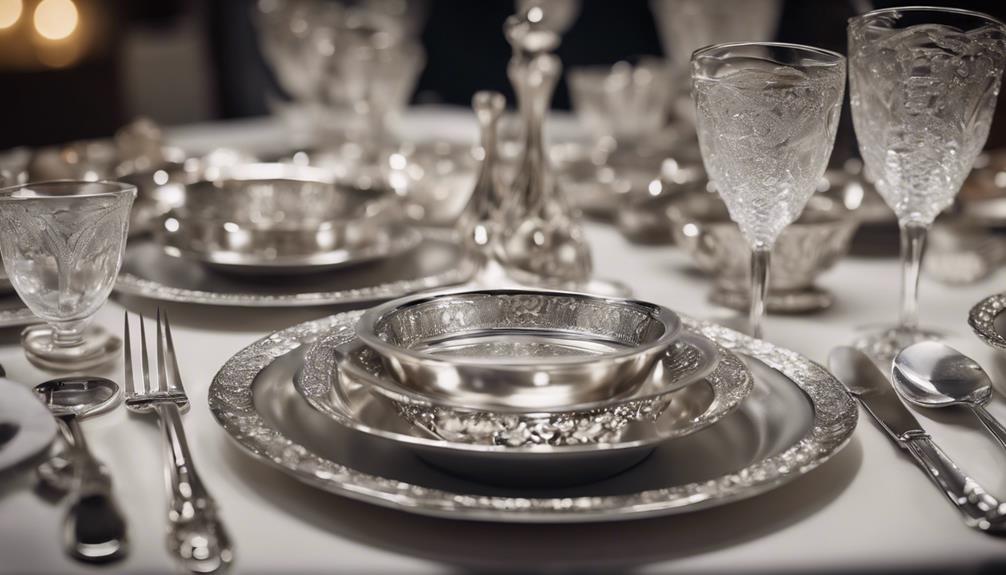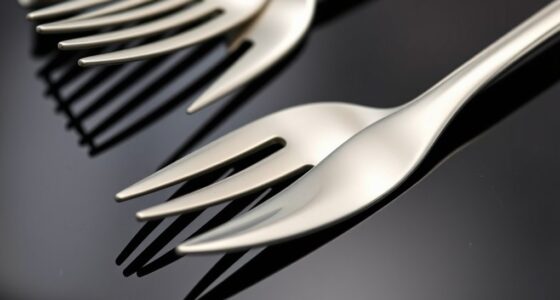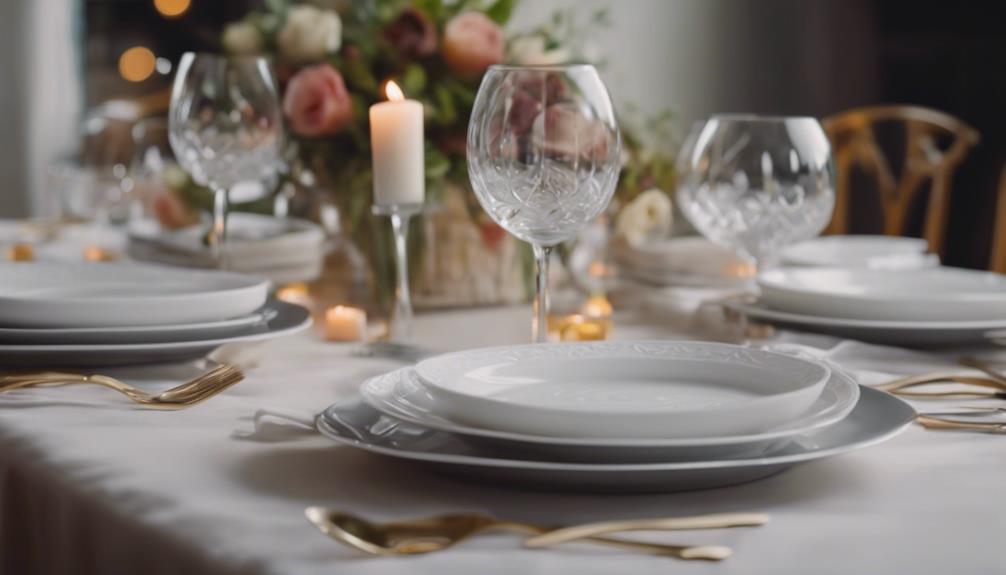To effectively care for your tableware, hand wash with a mild detergent to maintain quality. Follow manufacturer guidelines and handle with care to prevent damage. Dry thoroughly to prevent water spots, ensuring your dishes are completely dry before storing. Use soft cloths or sponges to clean gently, avoiding abrasive cleaners. Opt for suitable oils like tung or linseed to protect wooden or ceramic tableware. Store carefully in closed cabinets or on racks to prevent chips or cracks. Remember, proper care now ensures your tableware remains beautiful and functional for years to come.
Key Takeaways
- Hand wash with mild detergent to prevent damage and maintain quality.
- Dry dishes thoroughly to prevent water spots and maintain aesthetics.
- Store tableware in a closed cabinet to avoid exposure to sunlight and extreme temperatures.
- Use suitable oils like beeswax or tung oil to protect and enhance wooden or ceramic tableware.
- Handle with care, avoid high temperatures, and check dishwasher safe labels for ceramic tableware.
Importance of Tableware Care
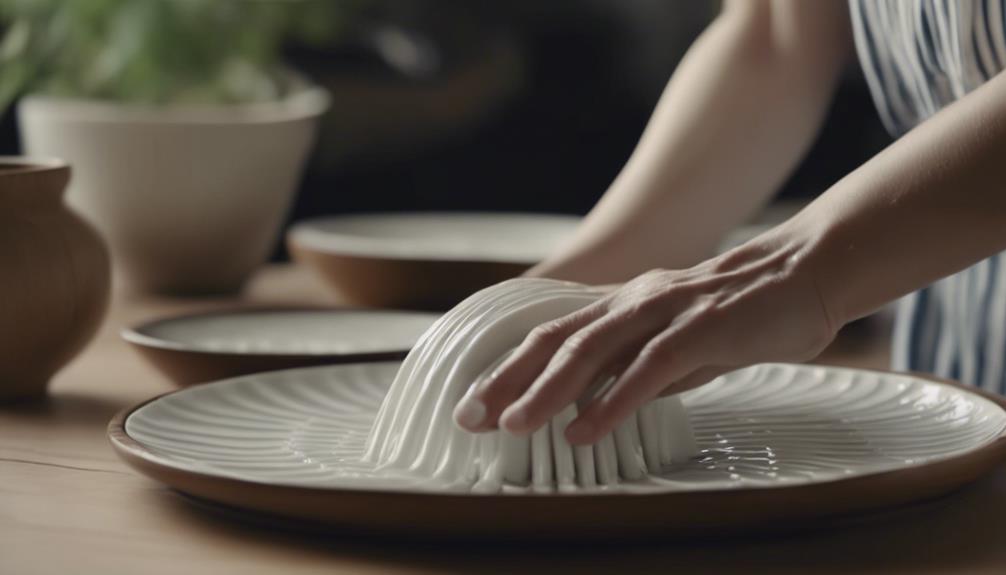
Taking proper care of your tableware is essential to guarantee its longevity and preserve its aesthetic appeal. Implementing a proper dinnerware care routine is vital to make sure that your tableware remains in top condition for years to come.
When it comes to cleaning, hand washing is often recommended to maintain the quality of your tableware. While some pieces may be labeled as dishwasher safe, hand washing is generally gentler and helps prevent any potential damage that could occur in the dishwasher.
By following the manufacturer's guidelines for cleaning and storage, you can help prevent cracks, scratches, and stains on your tableware. Remember, investing time in caring for your tableware pays off in the long run by keeping it looking new and functional.
Handle your tableware with care to reduce the risk of breakage and extend its lifespan. Proper care not only maintains the beauty of your tableware but also ensures its durability for many enjoyable meals to come.
Materials and Maintenance
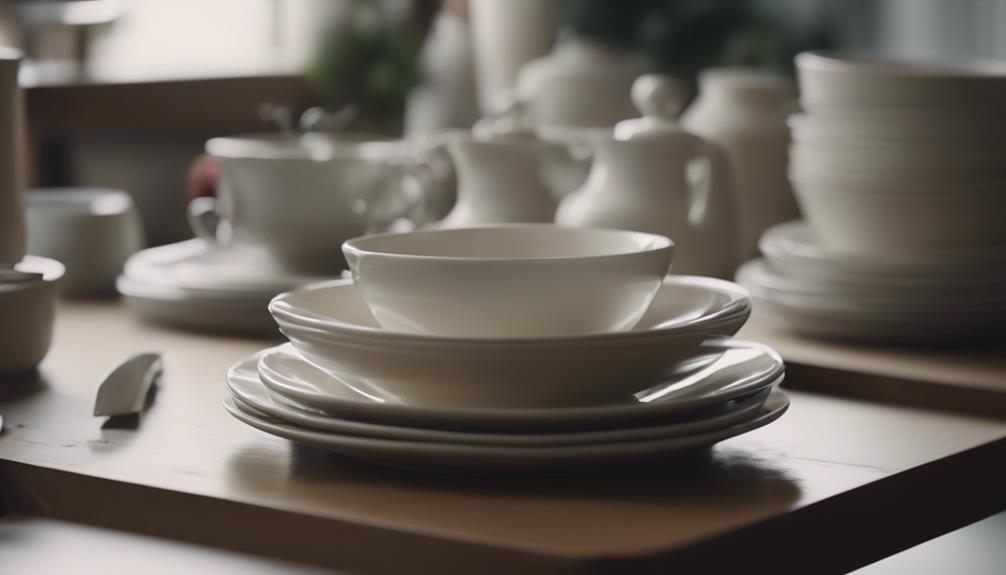
When tending to tableware, one must take into account the materials used and their specific maintenance requirements. Porcelain dinnerware is versatile, being safe for the dishwasher, microwave, and oven. However, hand-painted porcelain needs gentle care; it should be hand washed with a mild detergent to preserve its delicate design.
Glassware is generally dishwasher safe, but delicate blown glass pieces should be hand washed due to their fragility. Bone china, like The Artments Ritz Collection, should be rinsed before a final wash with low-chlorine detergents to prevent any adverse reactions.
Ceramic tableware, including stoneware and earthenware, should be hand-washed carefully to avoid chipping and to maintain their durability. Remember to avoid using harsh detergents or abrasive scrubbers on these materials to safeguard the longevity of your tableware.
Hand Washing Guidelines
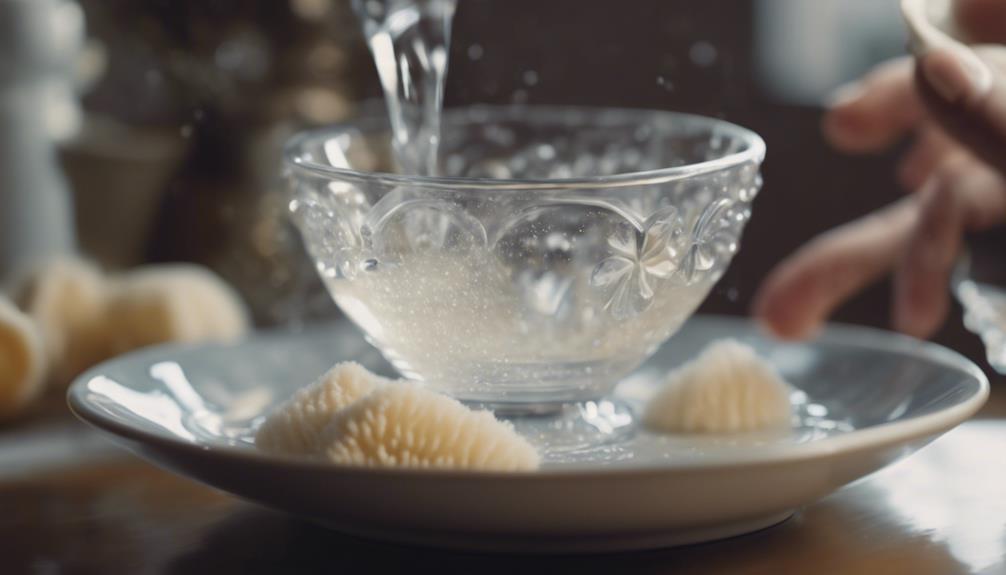
To hand wash tableware effectively, utilize a sponge and mild liquid dish detergent to prevent scratches. Using a soft cloth or sponge helps to gently clean your dishes without causing any damage. Harsh scrubbers can lead to scratches, especially on delicate materials. Make sure to avoid using abrasive cleaners that can further harm your tableware. By choosing a mild soap, you can effectively remove dirt and grime without compromising the integrity of your dishes.
When washing your tableware by hand, it's important to be gentle and attentive to avoid any accidental scratches. Employ a metal cleaner for scratches on tableware during hand washing, as this can help to restore the appearance of your dishes. Additionally, consider placing a plastic dishwashing container in the sink to cushion dishes while hand washing, providing an extra layer of protection. Remember to dry hand-washed dishes carefully using a soft dish towel to prevent water spots and damage, ensuring your tableware remains in excellent condition.
Proper Drying Techniques
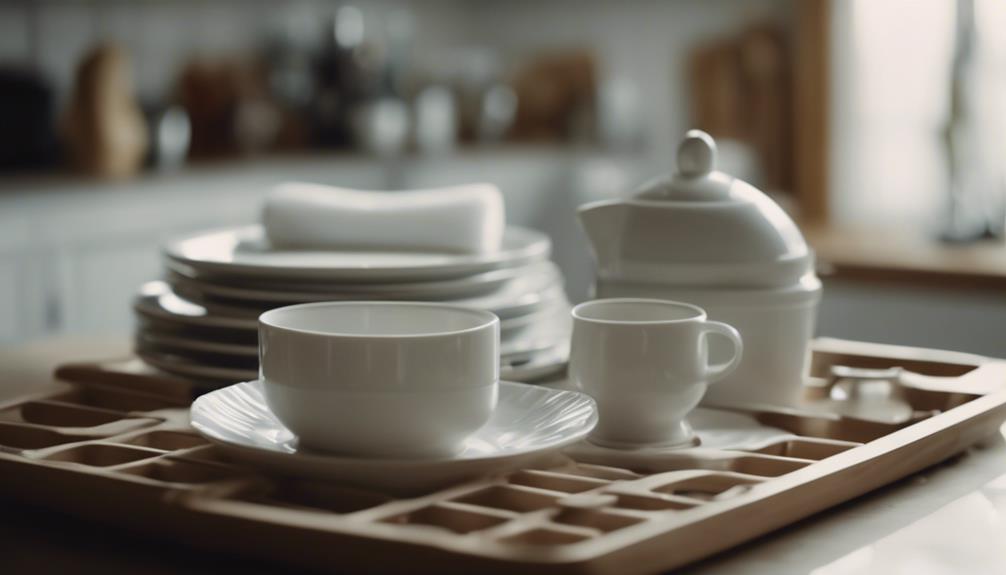
When drying tableware, remember to use an absorbent cloth for a gentle touch that won't damage delicate surfaces.
Make sure your tableware is completely dry before storing to prevent any moisture-related issues.
Letting your tableware air dry fully will help maintain its quality and prevent long-term damage.
Air Drying Method
For effective drying of your tableware, make sure adequate ventilation is available to prevent moisture-related issues. It's essential to air dry your tableware completely before storing them to avoid problems like mold or mildew.
Placing your tableware in a well-ventilated area promotes efficient air drying and prevents water spots or streaks on the surfaces. To facilitate the drying process, using a dish rack or drying mat can be very helpful.
Avoid stacking wet tableware items as this hinders air circulation and thorough drying. By following these air drying methods and tips, you can guarantee that your tableware remains clean, dry, and free from any moisture-related issues.
Towel Drying Tips
Consider using a soft, lint-free dish towel to gently dry your tableware, ensuring no scratches occur during the drying process. Hand-dry each piece individually to absorb moisture thoroughly and prevent water spots or mineral deposits.
Avoid storing wet tableware as it can lead to scratch marks and damage over time. High temperatures can also cause thermal shock, impacting the quality of your tableware.
Remember to hand-wash your tableware and dry it immediately after washing to maintain its appearance and longevity. Proper towel drying techniques play an essential role in preserving the quality and beauty of your tableware, so take the time to dry each piece carefully.
Rack Drying Benefits
Opt for rack drying your tableware to guarantee thorough and gentle drying that prevents water spots and promotes even air circulation. By using a dish rack, you can secure proper air circulation around your dishes, helping them dry evenly and reducing the risk of water spots and streaks.
Rack drying also helps to avoid the spread of bacteria and mold that thrive in damp environments. Additionally, this method is gentler on your tableware, minimizing the risk of damage compared to towel drying.
Not only is rack drying beneficial for the longevity of your dishes, but it's also a convenient and space-efficient way to care for your tableware after washing.
Storage Best Practices
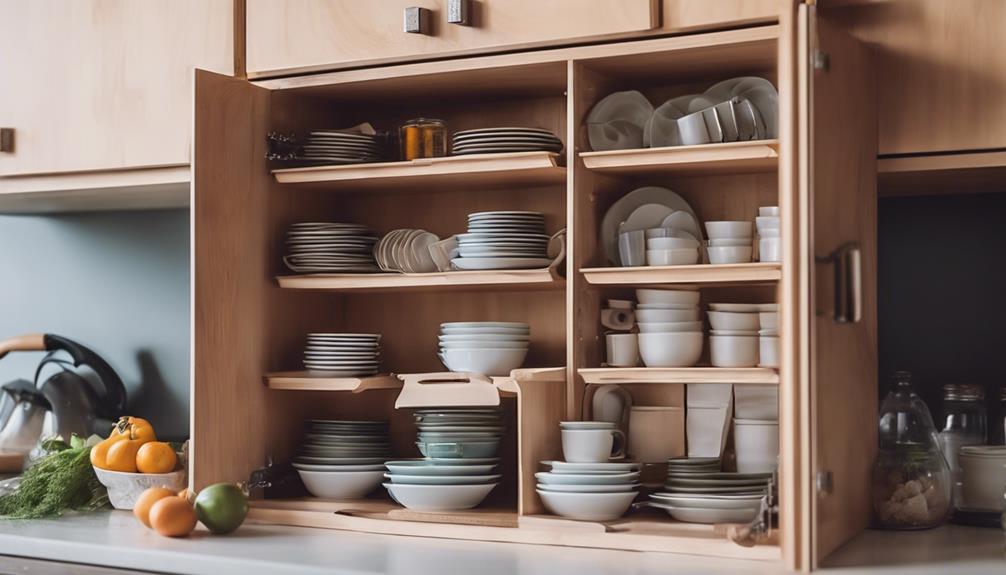
Store ceramic dinnerware in a closed cabinet to protect it from dust and damage. When washing your ceramic dishes, it's best to hand-wash them with a mild detergent to keep them looking their best.
After they're clean, utilize plate racks or shelves to store them upright, preventing scratches. Be cautious not to stack heavy items on top of your ceramic plates as this can lead to cracking. To avoid chipping, consider using rubber mats or foam separators between stacked plates.
Additionally, make sure your ceramic dinnerware is kept away from direct sunlight and extreme temperature changes to preserve them effectively. By following these storage best practices, you can maintain the quality and appearance of your ceramic tableware for years to come.
Using Suitable Oils
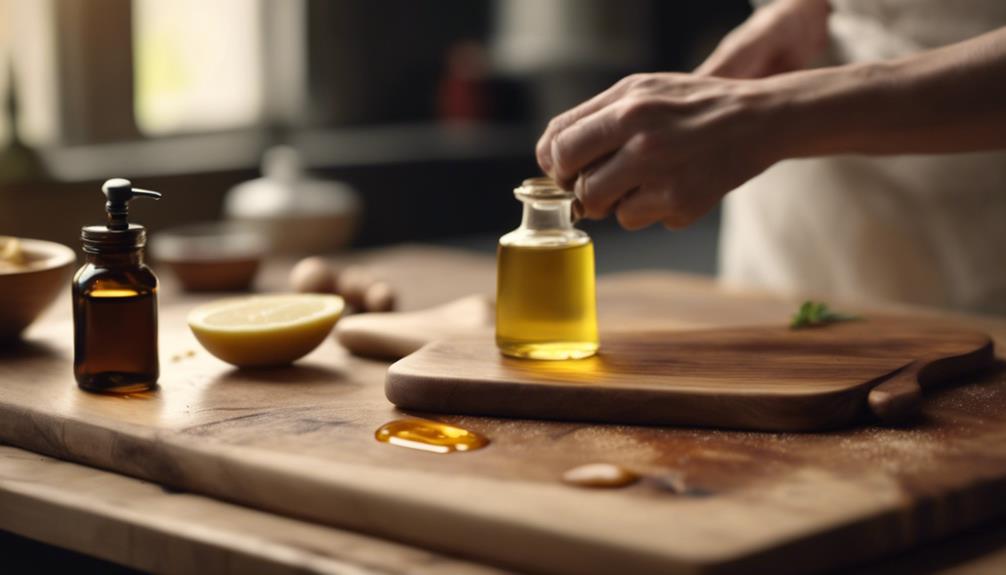
To maintain the quality and appearance of your wooden tableware, choosing suitable oils is essential for protection and enhancement. Beeswax is a popular choice for protecting and enhancing the natural beauty of wooden dinnerware. Tung oil provides a durable and water-resistant coating for ceramic dishes. Danish oil, a blend of varnish, oil, and drying agents, enhances the wood's color and grain, offering protection for dishwasher safe tableware.
Grape seed oil, a lightweight option, helps condition wooden dinnerware, preventing drying out and maintaining its appearance. For wooden tableware, linseed oil is a traditional choice that provides a natural finish and protection against moisture. Remember to avoid using silicone utensils with oiled tableware, as they may cause damage. When washing dinnerware treated with oils, opt for mild soap and gentle cleaning to preserve the oil's benefits for longer-lasting protection and beauty.
Preventing Common Tableware Issues
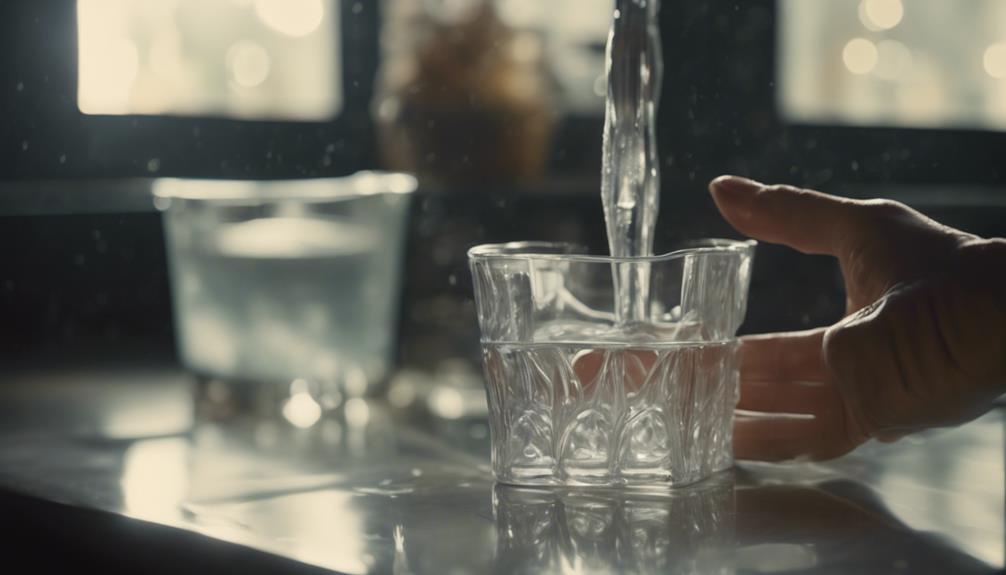
Prevent potential tableware issues by being mindful of temperature changes to avoid cracking or breakage. Rapid shifts in temperature can cause tableware to crack or break. Metal utensils can leave chips and cracks on delicate surfaces, so handle with care. Avoid exposing tableware to high heat or extreme cold, as this can lead to damage.
When stacking dinnerware, use felt protectors between each piece to prevent scratches. Prolonged exposure to high heat, like pouring boiling water directly onto tableware, can cause issues over time. To maintain the quality of wooden tableware, hand wash with mild soap and dry immediately to prevent warping.
Ensure tableware is stored in a dry, well-ventilated area away from direct sunlight and extreme temperatures to avoid any long-term damage. By following these simple precautions, you can guarantee your tableware remains in top condition for a long time.
Expert Tips for Longevity
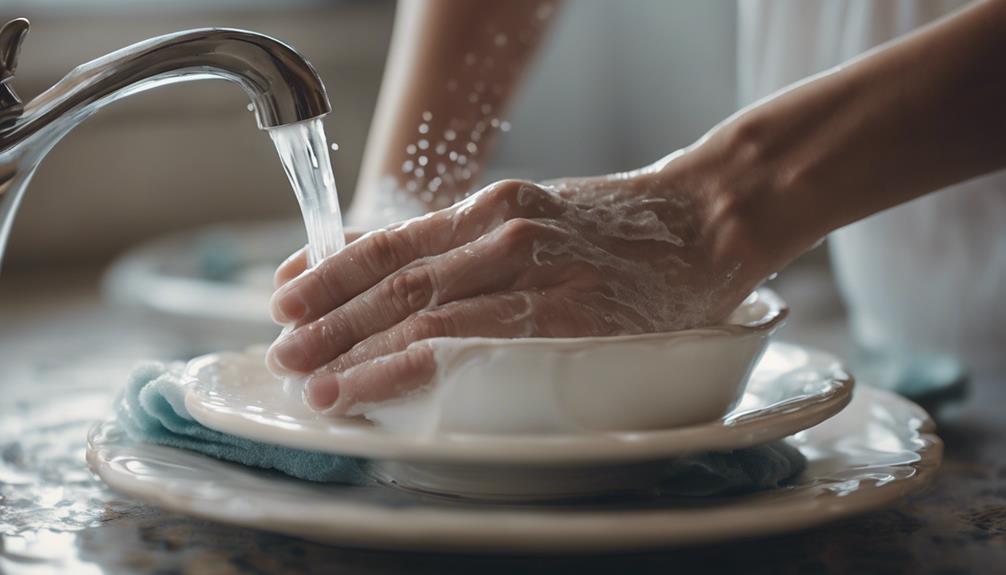
For expert tips on maximizing the longevity of your tableware, handle ceramic dinnerware with care to prevent any potential damage and extend its lifespan.
To guarantee your ceramic tableware lasts, make sure to:
- Avoid exposing to high temperatures: Prevent cracking or shattering by refraining from subjecting your ceramic dinnerware to sudden temperature changes.
- Take care when cleaning: Use mild dishwashing detergent and select appropriate dishwasher settings to maintain the quality of your tableware.
- Handle with care: Treat your ceramic dinnerware gently to avoid chips, cracks, or breakage.
- Check for dishwasher and microwave safe labels: Confirm that your dinnerware is suitable for these appliances to prevent damage during use.
Frequently Asked Questions
How Do You Care for Tableware?
To care for tableware properly, use mild dish soap and avoid harsh chemicals. Dry them right after washing to prevent water spots and damage.
Keep tableware in a dry, dust-free spot to maintain quality. Don't stack heavy items on delicate pieces to prevent breakage. Handle tableware gently to avoid scratches or chips.
Following these tips will help your tableware stay in top condition and last longer.
How Do You Handle Cutlery and Dinnerware Safely?
To handle cutlery and dinnerware safely, always use caution. Treat them like delicate treasures, avoiding harsh scrubbing or stacking them carelessly.
Dry them completely after washing to prevent water damage. Store them properly to prevent chipping or scratching.
What Is the Importance of Tableware?
Tableware is crucial for enhancing dining experiences, reflecting personal style, and adding sophistication to meal setups. Proper maintenance of tableware elevates food presentation, making meals visually appealing. Adequate care guarantees durability, longevity, and continued aesthetic charm.
Caring for tableware not only preserves its quality but also demonstrates respect for dining rituals and mealtime traditions. Investing time in upkeep showcases the value placed on creating memorable dining moments.
What Is the Etiquette for Dinnerware?
When it comes to dinnerware etiquette, remember to set the table with the main plate at the center and place utensils in order of use from the outside in. A charger plate can serve as a base for each setting, and don't forget to position the napkin to the left of the forks or on the plate.
Serve food from the left and clear dishes from the right to uphold traditional dining customs. Avoid loud utensil noises, slurping, or reaching across others during meals for a polished dining experience.
Conclusion
To sum up, taking care of your tableware is crucial to maintaining its quality and longevity. By following proper hand washing techniques, drying methods, and storage practices, you can prevent common issues and guarantee your tableware remains in top condition.
Using suitable oils can also help protect and nourish your tableware. By incorporating these tips into your routine, you can enjoy your tableware for years to come.
